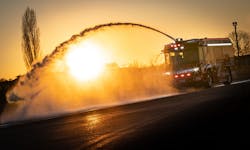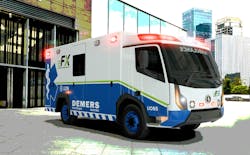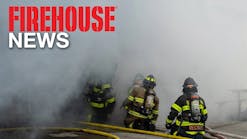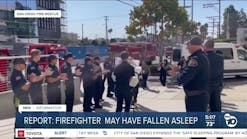A meme about electric fire apparatus shows a dispatcher fielding a 9-1-1 call. The dispatcher says, “Yes, ma’am, I realize your house is on fire, but the station’s electric fire engine is still charging.”
The meme has been shared with regularity. We aren’t surprised, because many in the fire service haven’t been made privy to the inner workings of electric fire vehicles. Like other innovations inside of the fire service and outside of it—even consumer electric vehicles (EVs)—it’s easy for people to be concerned about and/or second guess new technology when it moves off of the drawing board and into the marketplace. In fact, Firehouse Magazine applauds a dose of skepticism when it’s warranted. However, based on answers to questions that we posed to apparatus OEMs and fire departments that are familiarizing themselves with electric apparatus, we believe that rigs that have an electric drivetrain will prove their competence and worth sooner rather than later.
‘I hope they have a long cord’
Yes, the operation of an electric apparatus includes differences compared with the operation of its diesel counterpart, but those differences are few and supremely manageable. Yes, aspects of charging electric apparatus require a learning curve to ensure that no surprises emerge at a crucial time. However, no, engine companies don’t need to worry that the depletion of a vehicle’s rechargeable batteries on the fireground will cut short the capability to put water on fire.
“We like to compare [an electric engine] to having a Tesla with a diesel generator in the trunk,” Roger Lackore of REV Fire Group Engineering says in regard to his company’s Vector rig. “You operate a typical urban duty cycle all day on electric. You pump for two or three hours on a residential fire on all electric, but if the response is protracted or you are somewhere off the grid, the diesel ‘range extender’ will fire up.”
Eric Linsmeier of Pierce Manufacturing remarks similarly. “There are no sizing restrictions to the Pierce Volterra pumper simply because of the electrified driveline. All specific pumper specifications are reviewed and addressed, as any customer pumper would be.”
Scott Bavery, who is the assistant chief-support services for the Madison, WI, Fire Department (MFD), has fielded numerous inquiries from other departments during the MFD’s collaboration with Pierce on the shakedown of the Volterra. Among the top questions that are asked: How long does the vehicle last on a charge?
“The batteries have been absolutely unbelievable for us,” Bavery tells Firehouse Magazine. “We haven’t really had any issues.”
In addition to its RTX, which is in service—not being tested per se—at the Los Angeles Fire Department, and its RT, which the Berlin Fire Brigade in Germany has been running for about a year and a half, Rosenbauer developed a production-ready electric version of its Panther ARFF, the Panther 6x6. The latter can be charged in about 25 minutes for another typical emergency run. Of course, a backup generator is available for circumstances when battery power is depleted.
Lackore says the Vector has more than enough electric power to produce 1,500 gpm, although “you just can’t pump at 1,500 gpm from draft for as long” as you could pump from a hydrant.
True, the range on an electric apparatus—as on any electric vehicle—could suffer in cold weather, but that’s why the RTX, the Vector and the Volterra include a battery thermal management system, which keeps the battery modules warm in the winter (and cool in the summer).
Other particulars?
Bavery says that he and the MFD were just as interested in how the Volterra drives compared with a diesel counterpart as they were regarding battery life/pumping on scene.
“We didn’t want a driver to have to do something unique or different,” Bavery explains. “We didn’t want to have to put people through a big training to learn how to drive this vehicle.”
In fact, the MFD didn’t have to do that.
“It drives real similar,” Bavery says. “There are times when [a driver] might feel a little bit more power … but it doesn’t feel like a little sportscar.”
A Volterra will be arriving at Station 1 of Portland, OR, Fire & Rescue (PF&R) within a few weeks of the publication of this article. The vehicle will take the place of a conventional engine that’s due for replacement. The purpose of PF&R’s use will mirror that of the MFD’s.
From a drivability standpoint, Bill Goforth, who is deputy chief-logistics for PF&R, is interested in witnessing the vehicle’s performance on the hilly areas of the city, which extend for more than a hundred miles.
“I’m really excited about having a battery-operated vehicle that’s going to be able to give a sense of power to climb some of these steeper hills,” Goforth says.
“I just didn’t expect the acceleration and maneuverability that [Rosenbauer’s RTX] delivers with a full tank of water,” LAFD Deputy Chief of Operations Richard Fields says. Further, “The stability and weight balance of the vehicle is impressive.” Overall, the vehicle is “just flat out better than our combustion-powered engine.”
All that said, front and center in PF&R’s consideration of electric apparatus are efforts tied to Portland’s climate action plan and reducing carbon emissions, which also can be said for Madison and, to an extent, Los Angeles. Important for the residents of these municipalities, it’s also important for the city’s firefighters.
“Firefighters are going to be safer, because [the use of an electric apparatus] is going to reduce the diesel exhaust that can cause cancer,” Goforth explains.
“Certainly, the green aspect of electric apparatus is prominent, but the vehicles’ development also is about improving the daily working conditions for firefighters,” Todd McBride of Rosenbauer America adds. He explains that an adjustable suspension that’s part of Rosenbauer’s electric vehicle structure isn’t possible on conventional vehicles, because the tires would run into the latter’s frame rails, among other reasons. The adjustable suspension provides a 10-in. step up compared with 24 inches on the company’s conventional counterpart.
What about the well-publicized water tank leakage of LAFD’s RTX?
“It was a manufacturing issue with the tank itself,” McBride tells Firehouse Magazine. It had nothing to do with the electric drive.”Beyond pumpers
Rosenbauer is eyeing the manufacture of 40 electric pumpers in 2023. For the European fire service, the company already showed a turntable ladder, the features of which are exactly the same as those of the version that has a conventional drive.
Lackore says REV sees rescue apparatus as good applications down the road, with near-silent running being a key benefit. “The noise is greater on a [conventional] pumper or rescue apparatus equipped with direct-drive or hydraulic AC generators, because they must operate [the rig] in high-idle mode to produce the necessary power. An electric rescue apparatus can produce AC line voltage with no noise whatsoever.”
The question of adding aerial apparatus to the lineup is an instance of “crawl, walk, run,” Lackore notes.
That’s OK with the LAFD. “We’ll be waiting for the market to produce something viable for the tractor-drawn aerial,” Fields says.
So, too, will PF&R. “In a couple of years, we’re going to be replacing our mid-mount aerial bucket, and I’m hoping that the technology is out there [for electric aerials], especially if we have a charging station already set up at Station 1.”
“Then,” he adds, “of course, our ambulances.”
Prototypes of Demers eFX ambulance are planned for testing through early 2023, with the first delivery to the United States expected during the summer of 2023.
“Early models were used for hands-on trials with EMS providers that resulted in changes to the patient compartment cabinetry,” Greg Tucci tells Firehouse Magazine. Also, the design of the cab roof was altered to provide a better aerodynamic design.
Unsurprisingly, the manufacturer touts the vehicle’s significant torque and very quiet operation.
Lessons learned
What suggestions do the representatives of the three fire departments who we interviewed have for those who are considering electric apparatus?
“Lean heavy on local agencies and power companies regarding installing a charging system,” Bavery says. “There’s a way to go about installing a charging system at little to no cost. Our local utility actually donated the charger to us.”
Also regarding firehouse charging stations, Goforth says consider the installation of solar panels. PF&R’s Station 1's solar panels are providing electricity to the station but not the vehicle charging infrastructure. “In the future, we would like to have the solar panels tied into and provide enough electricity to the charger.”
LAFD’s Fields suggests that speccing an RTX to deliver adjustable ride heights might not be a lock. “It’s great, but unless I know that I’m going to take the rig into a wildland firefighting scenario, I might have to ask, “Do I really need it on a day-to-day basis.’”
Electric Apparatus & Station Design
By Rob Manns
When evaluating the effect on the space requirements and the electrical infrastructure that’s associated with deploying electric apparatus, it’s essential to understand where the industry is positioned regarding technological development. Most electric apparatus leverage batteries that have a 150–200 kWh capacity, requiring 300 amps and a 480-volt three-phase electrical service. We should expect future engines and trucks to exceed 600 kWh capacity. With that will come quicker charging capabilities, thus requiring an even more significant electric service than that which today’s electric apparatus demand.
For comparison purposes, a “non-EV-ready” 20,000-square-foot four-bay station might require between 800–1,200 amps of service. The same station that’s fully equipped for a fleet of 600 kWh+ electric apparatus might require as much as 2,500 amps. The power demands that are associated with such apparatus, which include three-phase high-voltage, high-amperage, electrical service, are costly, and they might not be readily available in rural areas. However, suitable backbone infrastructure should be less of a problem for new or renovated stations in urban areas.
Suppose you are planning a new station but aren’t ready to go in the direction of electric apparatus. You still might want to consider providing additional conduit sleeves and to upsize the electric room for future electrical expansion. Planning for the future will eliminate the necessity for future additions and simplify the upgrade process down the road.
Sprinkler systems & life safety
Electric vehicles (EVs) generally are safe. However, as a mission-critical facility, it’s paramount to protect a firehouse against the low-frequency, high-risk events that can cripple the capability to provide emergency service.
The conventional suppression method for an EV fire is to flood the battery with a tremendous amount of water. However, the volume of water that’s required to contain a battery fire far exceeds the typical capacity of a sprinkler system that’s designed for a conventional apparatus bay.
No explicit code, standard or path prescribes how to protect a fire station and its occupants from an electric apparatus fire. Although the NFPA and others recently started to develop standards and testing to address this, it could be several years before design requirements propagate throughout various codes and standards and, ultimately, are adopted by local jurisdictions.
In the event of an incident, if sufficient sprinkler protection doesn’t exist, significant battery involvement likely is to occur. A battery fire can continue to develop, potentially resulting in a thermal runaway, thus resulting in an uncontrolled fire. Because batteries typically are mounted to the chassis and located within a shell, even water produced from a more robust sprinkler system likely won’t suffice for extinguishment. In this instance, the overarching goal would be to mitigate the risk of igniting adjacent apparatus, minimize building damage, afford sufficient time for the building to be evacuated and grant the department a fighting chance to engage rapidly in targeted suppression efforts.
Planning process considerations
If properly planned, stations should serve their community for decades. For now, departments, architects and engineers must know the current and potential future risks.
One should engage local life-safety officials in the early stages of the planning process to develop an acceptable plan to mitigate the risk of loss of life and property. As you begin to evaluate purchasing electric apparatus or planning a capital construction project for a station, here are some things you might consider asking yourself:
· Have you considered future proofing or upgrading your fire suppression system?
· Are you planning to integrate high-challenge firewalls that separate the bays from occupied station portions?
· Did you consider strategically integrating wall-mounted handlines that might make suppression easier should things go wrong?
· Is your electric infrastructure and electric room sized for electric apparatus?
· If your department doesn’t have sufficient municipal water service, how will the increased sprinkler water demand affect holding tank and fire pump requirements?
· Does your region have the necessary power grid and infrastructure to support such an endeavor? If not, when will it come? If so, will this infrastructure still be suitable years from now as demand increases?
· Is a photovoltaic array (solar panels) a suitable solution for your region to help to offset the cost of electricity?
· Have you considered creative methods and procedures to remove an involved piece of apparatus from your station to mitigate the damage to the building?
Robert Manns is a principal architect with Manns Woodward Studios. He has more than 20 years of experience in the design of public safety facilities and has been recognized more than a dozen times for fire station design excellence.

Rich Dzierwa | Managing Editor, Firehouse Magazine
Rich Dzierwa joined Firehouse Magazine in 2019 after four tenures with other publications. He was editor-in-chief of Consumers Digest/ConsumersDigest.com and of trade magazine Cutting Tool Engineering. He served as the consumer products reporter for BridgeNews and began his publishing career with an 11-year tenure at Appliance magazine, where he rose to managing editor after serving in other roles. Dzierwa's experience with consumer products, including furnishings, appliances, electronics and space design, has transferred to his Firehouse work regarding the magazine's Station Design columns and the Station Design Awards. Previous work also has contributed to his supervision of several surveys of fire service/EMS members, to produce unique reporting for Firehouse's audience. Dzierwa earned a bachelor's degree in English from Columbia College Chicago.










